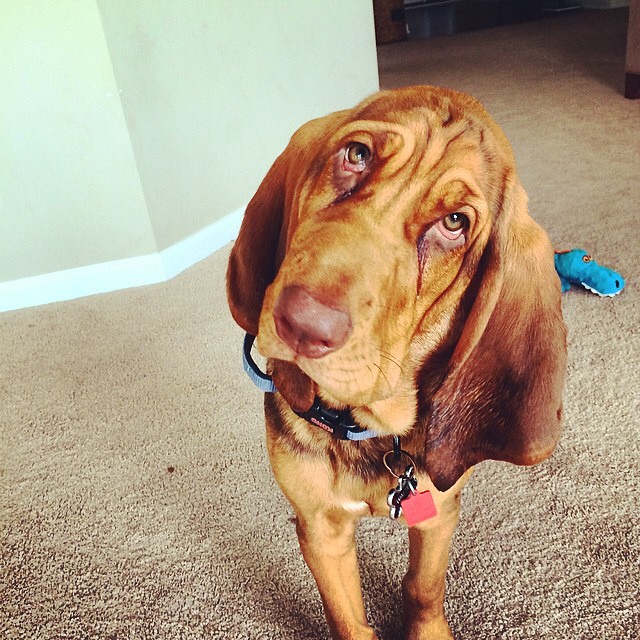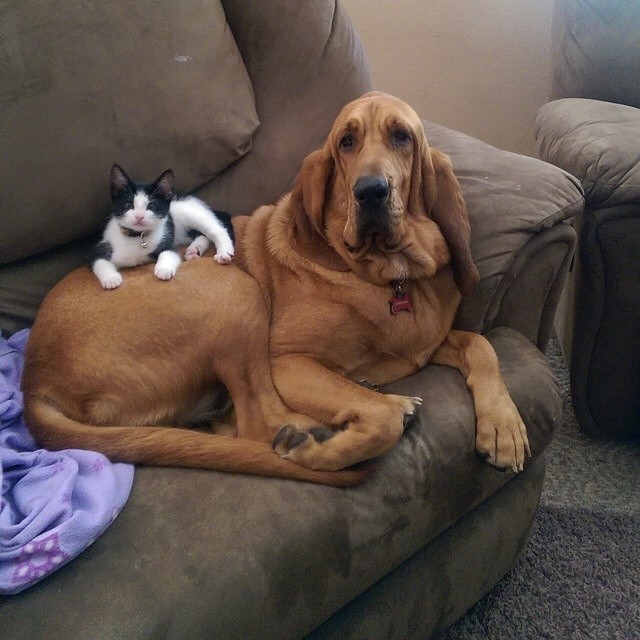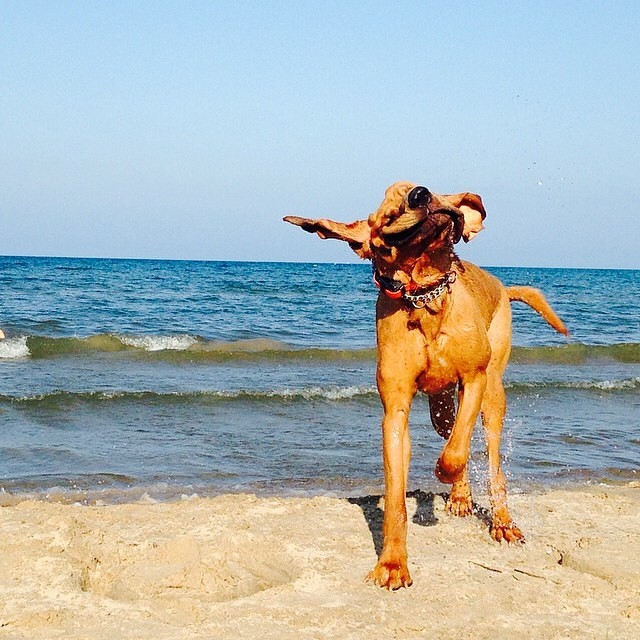Training a Bloodhound, a breed renowned for its remarkable sense of smell and tracking abilities, demands a unique approach tailored to their specific characteristics. Bloodhounds are not just ordinary dogs; they are a blend of gentle temperament and unparalleled scent-tracking capabilities. This combination calls for a training regimen that respects their innate skills while fostering obedience and discipline.

Introduction to Bloodhound Training
Understanding the Unique Characteristics of Bloodhounds
The Bloodhound is a breed with a rich history, initially bred for hunting and tracking. Their extraordinary sense of smell, among the most acute in the canine world, defines their personality and behavior. This keen olfactory ability means that Bloodhounds can become easily distracted by scents, making training challenging and incredibly rewarding.
These dogs are known for their endurance and persistence, which are beneficial in tracking but can pose challenges in a typical training setting. They are generally friendly and sociable animals, which helps their training, as they are often eager to please their owners. However, their size, strength, and strong-willed nature require a consistent and patient training approach.
Setting the Foundation for Successful Training
The key to successful Bloodhound training lies in starting early. As puppies, Bloodhounds are more malleable and responsive to training. Establishing a routine and consistent training methods from a young age is crucial. Positive reinforcement, particularly with food rewards, is highly effective due to their food-driven nature.
Training should be conducted in a calm, assertive manner. Bloodhounds respond well to calm and confident leadership. Establishing yourself as the pack leader is essential to gain their respect and attention. Consistency in commands and rewards helps the dog understand and follow the training regimen more effectively.
Bloodhound Health Considerations in Training
The health of a Bloodhound significantly influences their ability to learn and respond to training. Recognizing and addressing health concerns early is crucial for a fruitful training experience.
Essential Health Tests and Checks
Before embarking on any training program, ensuring that your Bloodhound is in good health is essential. Routine veterinary check-ups are crucial. These checks should include hearing and vision tests, as any sensory impairment can affect the dog’s response to training. Additionally, hip and elbow dysplasia screenings are essential, especially considering the breed’s susceptibility to these conditions.
Bloodhounds are also prone to certain genetic conditions, such as bloat and ear infections, which should be regularly monitored. A healthy Bloodhound will be more attentive, energetic, and able to participate in training sessions effectively.
Impact of Health on Training Effectiveness
The physical and mental health of a Bloodhound can directly impact their training. For instance, a dog experiencing joint pain from dysplasia may have difficulty performing specific commands or exercises. Similarly, a dog suffering from an ear infection might be less responsive to auditory cues.
It’s essential to adapt training methods to accommodate any health issues. For example, if a Bloodhound has joint problems, training sessions should be shorter and less physically demanding. In these cases, mental stimulation should be emphasized more to keep the dog engaged without causing physical strain.

Grooming and Its Role in Training
Grooming is integral to training Bloodhounds, maintaining their physical appearance, and building trust and respect between the dog and the owner. Regular grooming sessions offer an excellent opportunity to reinforce training, establish routines, and check for any health issues affecting the dog’s training progress.
- Skin and Coat Care: Bloodhounds have a short, dense coat that requires regular brushing to remove loose hair and maintain skin health. During grooming, it’s an excellent opportunity to practice commands like ‘sit’ and ‘stay,’ reinforcing obedience.
- Ear Cleaning: Due to their long, floppy ears, Bloodhounds are prone to ear infections. Regular ear cleaning is essential. This routine also accustoms them to being handled, which is beneficial for vet visits and other situations where they might need to be examined.
- Nail Trimming: Trimming their nails is essential for their comfort and health. Training your Bloodhound to stay calm during nail trimming is an exercise in patience and respect.
- Dental Care: Regular teeth brushing helps prevent dental issues and can be used as a training session to teach your Bloodhound to accept handling of their mouth and face.
Incorporating grooming into the training routine helps Bloodhounds learn to trust and accept various types of handling. This makes grooming easier and prepares them for situations where they might need to be examined by veterinarians or groomers. It’s a way to enhance their overall discipline and behavior.
Exercise Needs and Training
Exercise is a crucial component in the life of a Bloodhound, not just for their physical health but also as a vital part of their training regime. The right balance between exercise and training sessions can lead to a well-adjusted, healthy dog, both physically and mentally.
Balancing Exercise with Training Sessions
A well-exercised Bloodhound is more likely to be attentive and less prone to distractions during training sessions. It’s essential to strike a balance where the dog gets enough physical activity but is not too tired to learn and respond to training. Here’s a guideline to balance exercise with training:
- Morning Exercise: A brisk walk or a play session in the morning can help expend some of the dog’s pent-up energy, making them more focused during training.
- Training Post-Exercise: Conduct training sessions after the dog has had a chance to exercise. This helps in keeping their energy levels optimal for learning.
- Evening Exercise: An evening walk or play session can reinforce training commands learned during the day in a relaxed environment.
Exercise as a Training Tool
Exercise sessions themselves can be used as training opportunities. Incorporating basic commands like ‘sit,’ ‘stay,’ or ‘come’ during play or walks can reinforce obedience in different environments. Activities like scent-tracking games can also harness their natural abilities and keep them mentally stimulated.
Engaging a this breed in regular, structured exercise keeps them physically fit and aids significantly in their overall training and behavior management. It provides an outlet for their energy and helps nurture a disciplined and well-trained dog.

Core Training Principles for Bloodhounds
Training this breed requires understanding and implementing core training principles that cater to their unique temperament and abilities. These principles lay the foundation for a well-behaved and responsive dog.
Establishing Basic Obedience
Basic respect training is crucial for Bloodhounds. This training should start as early as possible and focus on fundamental commands to help manage the dog’s behavior. Here are the critical basic commands to focus on:
- Sit: Teaching your dog to sit on command is fundamental. It’s a building block for other commands and helps manage their behavior.
- Stay: This command is essential for keeping your Bloodhound safe and controlled, especially given their tendency to follow scents.
- Come: Recall is crucial, especially for a scent hound like the dog of this breed. It ensures they return to you even when distracted.
- Heel: Teaching them to walk calmly beside you is especially important given their size and strength.
- Leave it/Drop it: These commands help control what the dog picks up or follows, which is especially important given their scent-driven nature.
Advanced Training Techniques
As dogs of this breed are inherently skilled in scent work, advancing their training beyond primary obedience taps into their natural abilities and provides mental stimulation. Here are some advanced techniques:
- Scent Discrimination: Train your Bloodhound to differentiate between various smells. This can start with simple exercises like identifying different family members’ scents and progress to more complex smell puzzles.
- Tracking and Trailing: Leveraging their innate tracking ability, you can teach them to follow a scent trail. This can be done for fun or more serious purposes like search and rescue training.
- Area Search: Train your dog to search a specific area for a scent. This is particularly useful for search and rescue operations or competitive tracking events.
- Mantrailing: A specialized form of tracking where the hound learns to follow an individual’s scent trail over different terrains and environments.
- Obedience in Distracting Environments: Training your Bloodhound to follow commands in environments with strong scents or distractions hones their focus and discipline.
- Agility Training: Though less common for hounds, agility training can be a fun way to build physical fitness and respect. It involves navigating an obstacle course, which can be tailored to suit the dog’s abilities and interests.
- Advanced Recall Training: Given their tendency to get distracted by scents, advanced recall training is crucial. This involves training them to respond to the recall command even in the presence of solid distractions.
In advanced training, it’s important to keep sessions engaging and fun. Bloodhounds, with their keen sense of smell and desire to track, can enjoy these activities immensely, making training a rewarding experience for both the dog and the trainer. These advanced training sessions need positive reinforcement, patience, and consistency.
Behavior and Discipline Training
Behavior training involves teaching your Bloodhound appropriate behaviors and correcting unwanted ones. This includes house training, socialization, and learning to behave around other dogs and people. Consistency and patience are key in behavior training.
Focusing on these core training principles ensures that your hound grows into a well-mannered, obedient, and happy dog. It’s a rewarding journey that strengthens the bond between you and your pet.
Nutritional Considerations for Optimal Training
The nutrition of a Bloodhound plays a pivotal role in their training effectiveness. A well-balanced diet ensures they have the energy and health needed to participate in training sessions and maintain their overall well-being.
A hound’s diet should be carefully considered based on age, size, activity level, and specific health needs. Here are some critical nutritional considerations:
- High-Quality Protein: As active dogs, Bloodhounds require a protein-rich diet to support muscle development and repair. This is especially important for dogs engaged in regular training and exercise.
- Balanced Fats and Carbohydrates: Healthy fats are essential for sustained energy, while carbohydrates provide quick energy for training sessions. The balance between these nutrients is critical for maintaining optimal weight and energy levels.
- Vitamins and Minerals: Essential for overall health, vitamins, and minerals support various bodily functions, including bone health, digestion, and immune system functioning.
- Proper Hydration: To avoid dehydration, adequate water intake is crucial, especially during training sessions and in warmer climates.
It’s also important to consider the timing of meals for training. Feeding your Bloodhound a couple of hours before a training session can provide them with the necessary energy, and feeding them immediately after can help in recovery.

Consulting with a veterinarian or a canine nutritionist can provide tailored advice to meet the specific needs of your Bloodhound. A well-nourished dog is likelier to be alert, responsive, and healthy, contributing to more effective training.
Training Techniques and Methods
The training of a Bloodhound encompasses various techniques and methods, each tailored to the breed’s unique characteristics and learning style. These techniques not only facilitate obedience but also harness the natural abilities of the hound.
The Sit Command
The ‘Sit’ command is one of the most fundamental skills in dog training and serves as a cornerstone for establishing discipline and control. Training this breed to sit on command involves a few basic steps. Initially, it requires guiding the dog into a sitting position and associating this with the word ‘Sit.’ Reinforcement through treats and praise ensures the dog understands and follows the command. As the training progresses, the command should be practiced in various environments to ensure the dog obeys regardless of distractions.
The Down Command
Teaching the ‘Down’ command to a Bloodhound involves similar steps but requires the dog to lie down instead. This command is particularly useful in managing the dog’s behavior in various situations, from calming them in public spaces to preparing them for more advanced training exercises. Consistency in the command’s delivery and patience in allowing the dog to understand and follow the directive is crucial.
The Stay Command
The ‘Stay’ command is essential for maintaining control and ensuring the safety of the Bloodhound, especially given their tendency to follow smells. Training for this command starts with short durations and gradually increases as the dog becomes more adept at staying put despite distractions. Challenges in this command arise with increasing the distance and duration, requiring consistent practice and reinforcement.
Training a Bloodhound requires patience, consistency, and understanding of the breed’s needs. The right combination of these elements ensures that the training is practical and a bonding experience between the dog and the owner.
Specific Training Challenges and Solutions
Training a Bloodhound can come with its own set of challenges. Understanding these challenges and preparing to address them effectively is critical to a successful training experience.
Addressing Common Behavioral Issues
Bloodhounds, with their strong sense of smell, can often become distracted by smells, leading them off track or causing them to ignore commands. To address this, training them in environments with varying distractions and reinforcing their ability to focus is essential. Using strong-smelling treats can help in capturing their attention and reinforcing desired behaviors.
Another common issue is their vocal nature. Bloodhounds are known to be vocal dogs, which can sometimes become excessive. Teaching commands like ‘quiet’ or ‘enough’ can help manage their vocalizations. Positive reinforcement when they are quiet and consistent training to discourage unnecessary barking is essential in managing this behavior.
Specialized Training for Specific Needs
Some hounds may require specialized training for specific purposes, such as search and rescue, tracking, or even participating in canine sports like tracking trials. This specialized training should be based on the individual dog’s strengths and interests. For example, a hound keen interest in following scents may excel in tracking and smell work.
Training for these purposes often requires professional guidance and a more structured training regimen. It’s essential to recognize your hound’s individual needs and aptitudes and tailor the training accordingly.
Training a hound can be a rewarding experience. While they may present specific challenges due to their breed-specific traits, with patience, understanding, and proper techniques, these challenges can be effectively managed, leading to a well-trained and happy dog.
Resources and Support for Bloodhound Training

Embarking on the journey of training a Bloodhound can be exciting and challenging. To navigate this process effectively, it’s crucial to have access to the right resources and support systems. These can range from professional trainers and training schools to books, online resources, and community support.
- Professional Trainers and Behaviorists: Engaging with a professional dog trainer or a canine behaviorist can be highly beneficial, especially for first-time Bloodhound owners or those facing specific training challenges. These experts offer personalized guidance, addressing the unique needs of your dog. They can help with basic respect training and more specialized training needs, such as scent work or behavior modification.
- Training Schools and Classes: Enrolling your hound in a training school or classes can provide structured learning environments. Group classes also offer the added benefit of socialization with other dogs and people.
- Books and Online Resources: Numerous books and online resources are dedicated to training Bloodhounds. These can range from general training guides to specific topics like smell training or addressing behavioral issues.
- Online Forums and Communities: Joining online forums or communities of Bloodhound owners can be a great way to share experiences, get advice, and find moral support.
- Videos and Tutorials: Visual learning through videos and tutorials can be beneficial. Many professional trainers and dog training enthusiasts share their methods and tips through video platforms.
Having the right resources and support is critical to successfully training your hound. These resources provide guidance and information and offer opportunities for socialization and specialized training that can enhance your dog’s skills and behaviors. As you navigate the training process, remember that patience, consistency, and understanding your Bloodhound’s unique needs are vital to a rewarding training experience.
When to Seek Professional Help
While dedicated owners can manage many aspects of hound training, there are situations where seeking professional help is advisable. Understanding when to seek this assistance can significantly affect the dog’s progress and the owner’s confidence.
- Persistent Behavioral Issues: If your Bloodhound is exhibiting persistent behavioral issues such as excessive barking, aggression, or destructive behavior, professional intervention can be crucial. Behaviorists and trainers can provide specialized techniques and strategies to address and modify these behaviors.
- Training Plateaus: There might be times when, despite your best efforts, your Bloodhound seems to have hit a plateau in their training. A professional trainer can offer new perspectives and approaches, helping to overcome these stagnation points.
- Specialized Training Needs: For specialized training such as advanced smell work, tracking, or search and rescue, professional trainers with experience in these areas are invaluable.
- Health-Related Training Issues: If your Bloodhound’s training issues are related to or affected by health problems, it’s essential to consult with your veterinarian.
- Lack of Experience: If you are a first-time Bloodhound owner or new to dog training, seeking help from a professional can provide a solid foundation for your dog’s training. It also helps in building your confidence and skills as a trainer.
Recognizing the need for professional help is not a failure but a responsible step toward ensuring the best training and care for your Bloodhound. Professionals can provide the expertise, tailored approaches, and support necessary to address specific challenges, making the training journey more effective and enjoyable for the dog and the owner.
Conclusion: Embracing the Training Journey with Your Bloodhound
Training a Bloodhound is a journey that requires patience, consistency, and an understanding of the unique nature of this magnificent breed. As you embark on this journey, remember that each hound has their personality, strengths, and challenges. The key to successful training is recognizing and adapting to these traits.
Training your Bloodhound is not just about respect or mastering commands; it’s about building a trusting relationship between you and your dog. It’s a journey that will teach you as much about patience, communication, and perseverance as it will teach your dog about obedience, discipline, and behavior.
Celebrate the small victories along the way, and don’t be disheartened by setbacks. Training a Bloodhound can sometimes be challenging, but the rewards are immense. A well-trained hound is a joy to have as a companion and a testament to the dedication and love you have invested in their upbringing.
Remember that resources are available to help you, from professional trainers to online communities. Feel free to seek support and advice when needed.
In closing, embrace this training journey with enthusiasm and an open heart. The bond you will build with your Bloodhound through training is mutual respect and affection, lasting a lifetime. Enjoy every moment of this rewarding experience.
